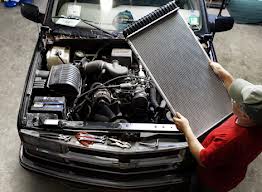News
Some Common Sense on the Working Principle and Sructural Des
Automotive radiators have been playing a significant role in the whole auto system since their first exhibition in 1901. Of course they are and we are able to make sense of this statement, but why? Here I would like to list several reasons before starting to talk about the main topic of this passage.
When automobiles are running at a relative high speed, the fuel combustion inside the engines will produce a large amount of heat, which cannot be sent out immediately without any help from other devices. This is exactly why auto radiators are needed here. See, if they do not participate in the whole mechanical structure, something wrong may happen because of the higher-and-higher temperature. First, many parts of the internal combustion engine might have some deformation occurred and the strength of metal pars could also decrease. All these would lead to an abnormal coordination between them and then the car could even break down. In addition, the viscosity of the lubrication oil would drop down along with the rising temperature. With a low viscosity, the oil might easily flow away among the parts instead of staying around to do its own jobs. What's more, a pretty high temperature might even cause a deflagration to cars. That could be considerably dangerous.

Unil now, we have got a further knowledge on the reasons why auto radiators, especially racing radiators, are in such a central position in their owners. Next, let us have a look at what stuff ensures this unshakable position for them, namely, their working principle. Autually, the thing here is very simple. An auto radiator is just a device that can provide heat exchange between two fluids, the air and the coolant. Yet, there is still something complicated to be noticed. It is about the specific transferring process. When the coolant accept a part of heat from the engine, it takes the heat to the coolant boundry layer inside the water pipe. After diffusing though the metal walls of the water pipe and the heat dissipation plate they are the two main components of an automobile radiator which are combined by welding, the heat come and cling to the cooling air boundry layer outside the walls. At last, it will wait there to spread out to the atmosphere.
As far as can be seen from above, the whole thermal resistance of an auto radiator consists of three pasts: resistance of the pipe boundry layer, the metal itself and the air boundry layer. According to some experiments, the resistance of the air boundry layer takes up the most proportion so to reduce this part is the key to a general improvement of the heat dissipation efficiency. The latest design has changed the heat dissipation plate from plain into a wavy shape. By doing so, the contact area between air and the plates can be greatly enhanced and more heat will be sent ou in shorter time.
Having inspected why', let us have another shot at ‘how'. Sructures of the automotive radiators are able to demonstrate that. Commonly, an auto radiator consists of a radiator core, motherboards, sideboards, a top water chamber and a bottom water chamber, a water entrance and a water exit, an overflow pipe, a radiator lid and some other parts. I will pick out the most important ones and present them with more details.
Water pipes and heat dissipation plates are the basic elements of a silicone radiator hose, which is, in turn, the central part of a radiator. They are the critical factors to decide whether the radiator can own a high working efficiency. Things about the plates have already mentioned before. As for the water pipes, they always adopt flat round as there cross sections and the purpose is same to let more heat out quickly, for it can possess a larger cooling area compared with the round-section pipes with identical volume. Besides, the flat round are also able to prevent a frost crack if it is very cold in winter.
Motherboards are the connecting structures in a radiator and they should be both easy to assemble and solid enough to support the whole device. On one side is the water chambers which offer coolant to the system. On the other side is the water pipes to accept coolant and take in around the engines. Therefore, their construction should exactly suit these to components. The sort order and number of the water holes have to be completely same as those of the water pipes, or it cannot work smoothly.
The significance of the radiator lid is also worthy to say. It is known that water's boiling point depends on its barometric pressure. While at work, some vacuum may cause a drop of water's saturated vapor pressure, so there is a necessity here to add some pressure. That is why the pressure of cooling system is a little bit higher than the normal value. But this extra must be under revere control and the radiator lid is just in charge of it. When the system pressure goes beyond the set value, it has to relief it and when the pressure does not reach the set value, it has to compensate for it. Otherwise, the radiator will get damaged.
Related articles:

